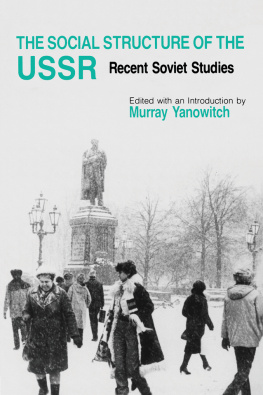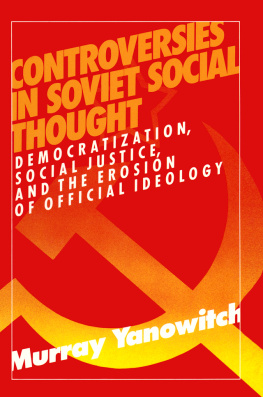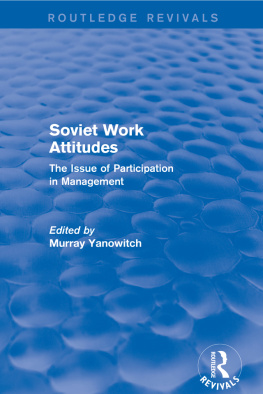Social Stratification and Mobility in the USSR
SOCIAL STRATIFICATION AND MOBILITY IN THE USSR
EDITED AND TRANSLATED WITH AN INTRODUCTION
by Murray Yanowitch HOFSTRA UNIVERSITY
and Wesley A. Fisher COLUMBIA UNIVERSITY
WITH A COMMENTARY BY
S. M. LIPSET HARVARD UNIVERSITY
First published 1973 by International Arts and Sciences Press, Inc.
Reissued 2018 by Routledge
2 Park Square, Milton Park, Abingdon, Oxon OX14 4RN
711 Third Avenue, New York, NY 10017, USA
Routledge is an imprint of the Taylor & Francis Group, an informa business
Copyright 1973 by Taylor & Francis.
No part of this book may be reprinted or reproduced or utilised in any form or by any electronic, mechanical, or other means, now known or hereafter invented, including photocopying and recording, or in any information storage or retrieval system, without permission in writing from the publishers.
Notices
No responsibility is assumed by the publisher for any injury and/or damage to persons or property as a matter of products liability, negligence or otherwise, or from any use of operation of any methods, products, instructions or ideas contained in the material herein.
Practitioners and researchers must always rely on their own experience and knowledge in evaluating and using any information, methods, compounds, or experiments described herein. In using such information or methods they should be mindful of their own safety and the safety of others, including parties for whom they have a professional responsibility.
Product or corporate names may be trademarks or registered trademarks, and are used only for identification and explanation without intent to infringe.
Publishers Note
The publisher has gone to great lengths to ensure the quality of this reprint but points out that some imperfections in the original copies may be apparent.
Disclaimer
The publisher has made every effort to trace copyright holders and welcomes correspondence from those they have been unable to contact.
A Library of Congress record exists under LC control number: 72077202
ISBN 13: 978-1-138-59987-1 (hbk)
ISBN 13: 978-0-87332-008-5 (ebk)
To Our Soviet Colleagues
in the Study of Social Inequality
Acknowledgments
The editors are most grateful to Fred Ablin, Editorial Director of International Arts and Sciences Press, for his invaluable assistance in seeing this volume through its many stages from inception to final publication. Our thanks also to Michel Vale for his translation of the article by M. Kh. Titma (the final version is, of course, our responsibility), and to Lynn V. Fisher and Mirra-Rene Visson for assistance in solving some of the thornier linguistic problems.
Contents
Murray Yanowitch and Wesley A. Fisher
Iu. A. Levada
O. I. Shkaratan
G. V. Mokronosov
L. A. Gordon and E. V. Klopov
Iu. E. Volkov
O. I. Shkaratan
Iu. V. Arutiunian
Iu. V. Arutiunian
M. V. Timiashevskaia
V. V. Vodzinskaia
M. Kh. Titma
M. N. Rutkevich and F. R. Filippov
M. N. Rutkevich and F. R. Filippov
L. F. Liss
O. I. Shkaratan
Iu. V. Arutiunian
S. M. Lipset
MURRAY YANOWITCH AND WESLEY A. FISHER
The selections from Soviet sociological literature presented in this volume are significant from at least three standpoints. First, they reveal the extent to which the issue of social and economic inequality has become a subject for legitimate public discussion in the Soviet Union. In a society whose political leaders and mass media frequently reaffirm the goals of achieving full social equality and the building of a socially homogeneous society, sociologists studies of Soviet social structure have become part of a public discourse whose audiences and participants are vastly broader than the ranks of Soviet sociologists. Indeed, the latter including some whose work is represented in this volume are not infrequently called upon to discuss their work in mass-circulation newspapers and magazines. () Hence the selections, although drawn largely from the professional literature, provide at least a rough picture of the way in which problems of social and economic inequality are defined and presented to the Soviet reading public at large.
Second, these selections offer the reader a means of appraising the quality of work in what, under Soviet conditions, is the formative period of a new intellectual discipline. The Soviet Sociological Association was founded as recently as 1958. () (With two exceptions, the materials included in this volume were originally published in the Soviet Union in 19701971.) Soviet academic sociology stratification and mobility research in particular has thus had little more than a decade in which to develop. Nonetheless, enough serious work has been produced in this relatively brief period to justify its presentation to Western sociologists interested in discovering for themselves the range of interests, conceptual apparatus, and degree of technical sophistication exhibited by their Soviet colleagues.
Third, the selections provide abundant empirical evidence bearing on the forms and degrees of inequality currently found in Soviet society. The samples on which the empirical studies are based encompass a wide spectrum of occupational groupings and are drawn from a variety of locales. Much of the data gathered in these studies on differences in income, prestige, decision-making power, life-styles, and access to education appear in the selections presented below. Thus, readers interested primarily in comparative social structure, social inequality, and mobility should find a rich harvest of materials here.
The remainder of this introduction will briefly consider: (a) some factors contributing to the emergence of Soviet studies of social stratification, (b) changing Soviet conceptions of social structure, and (c) the explanations offered by Soviet sociologists for the perpetuation of social inequality in the USSR.
Why the Emergence of Soviet Studies of Social Stratification
A good many of the Soviet scholars working in the newly legitimated area of sociology in the USSR have turned their attention to problems of social stratification. Indeed, stratification is a relatively more popular topic among Soviet sociologists than among American sociologists. Social Structure of Soviet Society ranked fifth in popularity in a list of forty current research topics of the members of the Soviet Sociological Association in 1970. In contrast, Stratification and Mobility ranked only fifteenth out of thirty-three areas of competence listed by members of the American Sociological Association in the same year. Proportionately more Soviet than American sociologists are currently engaged in research on problems of stratification (approximately 4.4% of the members of the SSA as opposed to 3.0% of the members of the ASA in 1970). ()
In part this emergence of stratification and mobility research in the Soviet Union has been a response to the needs of state authority. Certain new social problems (disproportions in Soviet parlance) bearing on stratification and mobility appeared in Soviet society in the 1960s. The possibility that the work of sociologists in this area could be used to meet these problems undoubtedly made the authorities receptive to certain kinds of stratification research, and provided an opportunity for sociologists to legitimate their discipline further through proof of its potential service in the management of public affairs.








